by scott.gillum | Jul 2, 2013 | 2013, Marketing
A week doesn’t go by that I don’t hear clients express concern about their ability to produce a consistent flow of quality content, yet every day my inbox is full of emails offering white papers, research, webcasts and blog posts.
So we set out to solve this “paradox of content marketing.” How is it that clients are not able to produce quality content for their purposes, but I get an average of 35 emails a day offering me content?
Our Approach
With the help of our summer intern, Sergio Pianko from Georgetown, I archived a weeks worth of content related emails sent to my primary work email. For this experiment, I did not include any other personal email accounts, social media or offline publications.
The Findings
Content Volume
For the week, I received 217 unique emails containing access to 1,131 pieces of content. Thursday was the peak day of the week, which surprised me, with 9 am being the peak time of day, which didn’t. I received an email offering me content, on average, almost every 15 minutes.
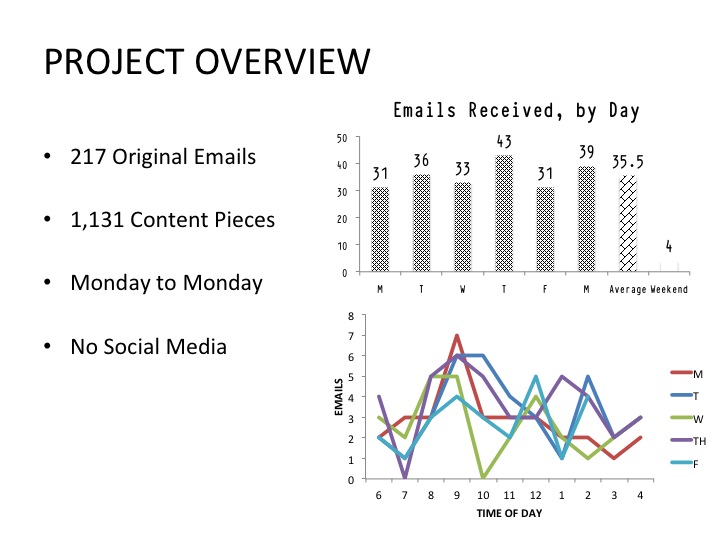
Content Type
A new report by the CMO Council entitled Better Lead Yield in the Content Marketing Field found that 87% of the respondents said that online content plays a major or moderate role in influencing vendor selection. The content they trust and value most? Professional association research and whitepapers 67%, industry research reports and whitepapers and customer case studies. The least valuable was vendor content, with 67% saying they don’t trust it.
What’s in my inbox? Well, I’m partial to content aggregators. My two favorites providers are MediaPost because of their ability to narrow the scope on relevant topics, and their expansive content producers (including this author). I also like SmartBrief publications, they provide e-newsletters on behalf of others, like the BMA. I find the layout to be quick and easy to peruse, and they usually feature a research offer.
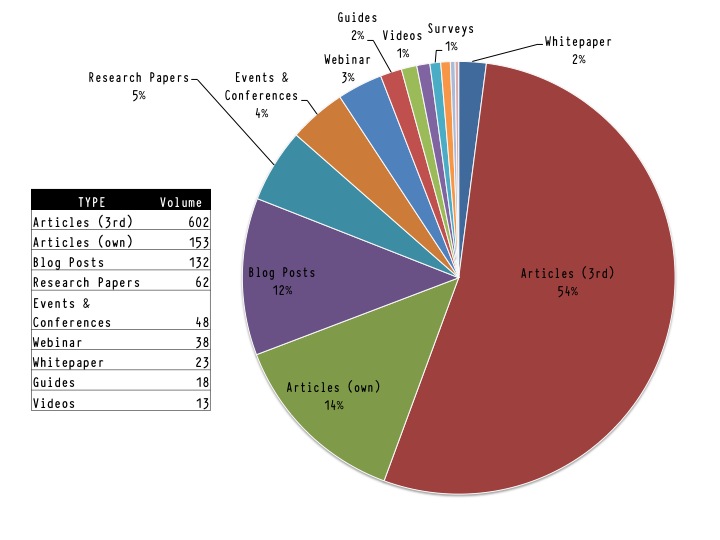
It was interesting to see that even though White Papers were mentioned to be the most valuable content piece according to B2B buyers, it represented less than 2% of the content I received.
Key Insights
Stop Calling Me
Downloading content that you offer for free does not make me a prospect. Save the $25 dollars you’re spending on the outbound telemarketing call and use it to track my behavior until I am qualified. Still not enough for you, we get that “free” comes with a price so consider this payment. According to the CMO Council report 87% of B2B buyers share your content with 5 or more people. Remarkably, 28% mentioned that they share it with more than 100 folks.
Overweight Content related to the Business Case
The first phase of the buyer journey is research. A prospect can cycle in this phase for weeks, even months, never reaching the next step, which is the business case. If you want to qualify real prospect, focus on providing them content that is related to making a business case for buying your product or service. For lead nurturing, overweight the scoring for pages or content that relate to this as well.
Content is not King, nor is Relevancy, Actionable is the Opportunity
Sergio sorted the content using four filters; Relevancy, Usefulness, Credibility, and Actionable, based on the definition in the chart (below). For the most part, I had selected information sources that produce relevant content, and because of my use of aggregators it kept me informed about industry develops or issues relating to my clients. We then check into the backgrounds of the content authors and found that for the most part, they were credible using our definition (below). But along the way Sergio did discover a couple of frauds, not surprisingly in the social media space.
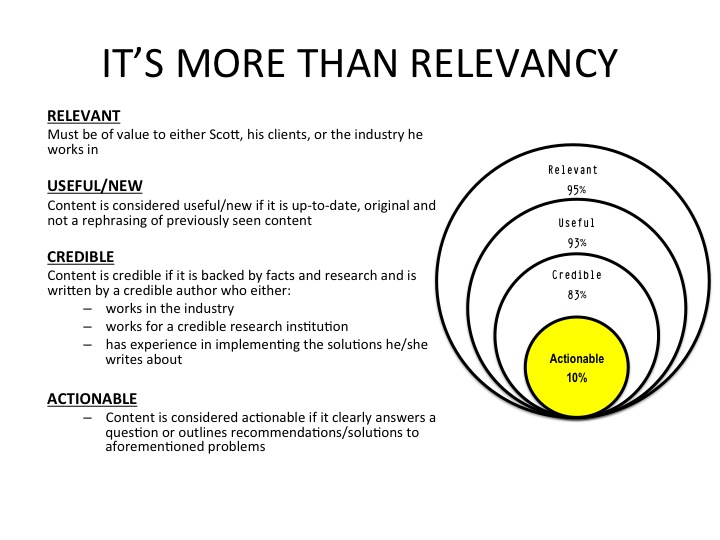
The most interesting findings was that very little (less than 10%) of the content was “actionable” in that it provided recommendation/s or solutions to the problem or issue discussed. And most of the actionable content came in the form of Webcasts. As a content marketer this is the opportunity and, given its value, think strategically about how you deliver it. Because of the scarcity of this type of information, you can request an exchange of value with the audience, be it contact information, attendance at a webcast, etc.
Opportunity #2 – Video
Numerous studies have pointed to the growing influence and use of video content. Yet it represented only 1% of the content I was offered. Yes, it is more complex, time consuming and expensive but it will also drive better results. It’s worth exploring, from past experience early innovators reap the greatest rewards.
Develop Buyer Personas
To understand some of the findings it may be helpful to know my email and content profile. I am an active content seeker and email deleter. Unlike some colleagues and friends, I like to keep a neat and tidy inbox. I delete emails early in the morning, and late afternoons. During the day I may delete emails as previews flash on the screen. Also, because of my consulting background, I am drawn to market research and data oriented content. I download and archive many items that I later review…typically on planes.
That’s my content “persona.” Agencies have been creating audience personas for years and now, if you’re a client side marketers, it’s your turn. According to the Demand Gen Blueprint survey only 25% of marketers have developed buyer personas, and of those who have, only 35% have mapped content to buyer stages.
Who Does it Best?
To win, you have to make it in the inbox, get the email open and the content viewed. The organization that does that best, in this man’s opinion, is IBM. For their insight into the C-Suite, quality of research, and frequency of contact…which is only when they have something of value. They are the only “vendor” I let in my inbox.
Runner up is McKinsey, for their “big picture” thinking and ability to take complex problems and explain them in very simple terms (especially in 2 min videos). Best New “Up and Comer” is the Aberdeen Group, a recent change in their business model allows free access to quality research, which this “freegan” appreciates.
Content marketing will only grow in importance for business marketers over the next few years. There are opportunities to get your information viewed, and shared, but to accomplish that you have to understand your audience’s content consumption behavior, provide them something of value, and deliver it in the channel and/or through the content provider they prefer.
There is a lot of work to be done, so have at it. Looking for a starting point, do a similar experiment with your customers. Ask them to send you a weeks worth of content related emails, you’ll be surprised by what you find.
by scott.gillum | Jun 10, 2013 | 2013, Marketing
 This time of year, America’s third or fourth (depending on where you live) most popular sport gets its moment in the sun. The Stanley Cup finals begin this week and the nation’s attention turns to ice, hockey sticks, pucks, and maybe mullets.
This time of year, America’s third or fourth (depending on where you live) most popular sport gets its moment in the sun. The Stanley Cup finals begin this week and the nation’s attention turns to ice, hockey sticks, pucks, and maybe mullets.
For business marketers, the “holy grail,” or in this case the “Stanley Cup,” has been trying to demonstrate the business impact of social media. Not defined by adoption, usage, or engagement, but by influence. Proving that social media and/or social networks can influence buyer behavior. New insight suggests that it might be time to lace up the skates and put on the pads.
Word of mouth (WOM), defined by person-to-person communication be that in person or over the phone, is and has always been the most used, and most influential channel for business buyers. Sometimes also described and measured as NPS (Net Promoter Score), it is the “Wayne Gretsky” of driving influence among decision makers, both in new acquisition, and for renewal.
Unlike WOM, Social Media has struggled with demonstrating influence. Adoption and usage rates continue to grow, but the impact on B2B decision makers has been difficult to nearly impossible to measure (btw – this is not unlike other, more established media channels).
That was until now. Research from Buyersphere may give us a clue to how social media may influence decision makers in the near future, and it has given us a couple of “hockey sticks” and a “puck” to play with.
According to Buyersphere’s Annual Survey of B2B Buyer Behavior, even though buyers mention social media (and providers such as Twitter, Facebook and Linkedin) when asked to rate their usage and the usefulness of channels when searching for vendors, they fall off the grid when asked to evaluate their influence. As you would expect, word of mouth came out on top.
Diving deeper into the research, it revealed a few game changing findings. Twenty to thirty year olds (Gen Y), act like no other previous generations. The first “hockey stick” is somewhat known — twenty-something business buyers are roughly twice as likely to seek information or advice from social media as the generation before them (31-40 year olds). And almost four times more likely to than the baby boomers (51-60 year olds).
 The second hockey stick, and the one that may end up being somewhat problematic for marketers, is that 49% of Millennials stated that they wanted to create and publish their own professional content. They not only want your content, but they also want to be able to disassemble it and repackage it with their own point of view.
The second hockey stick, and the one that may end up being somewhat problematic for marketers, is that 49% of Millennials stated that they wanted to create and publish their own professional content. They not only want your content, but they also want to be able to disassemble it and repackage it with their own point of view.
And finally, the puck to play with is that buyers under 30 are the only group that describe word of mouth as social media first, and then phone or in person. Close to 50% of Gen Y buyers defined WOM as any social media, in person or phone, mentioned by only 33% of the respondents. Buyers 40-50 by contrast, define WOM as in person or phone 60% of the time with any social media platform only 23%.
Game On
Marketers most powerful and influential channel is now being redefined, and this presents the best opportunity to date to demonstrate the impact of social media on buyer behavior. “To skate to where the puck is going to be” as Gresky used to say, we need to plan now.
To define the approach we need to understand the components of “social media” that are often lumped together – social networks and social media. Social networks refer to the connection among users and their social structure (friend, business acquaintance, etc.).
Social media is defined as the online channel used to generate, access and distribute content. The distinction is important because of the way different generations of business buyers use and value them. This is key to unlocking influence.
We know that their social network heavily influences Gen Y, more than any other generation. We know that half of them want to produce and share their own content, 60% upload content to the web, and 62% rate products and services on the web.
So for Enterprise accounts, where Gen Y is 5-10 years from occupying the C-Suite, take a lesson from McDonalds and “grow your own customers.” Get Gen Y hooked on your content by involving them in your brand and making your content modular so it’s easy to repackage and share. The route to influence is through cause marketing efforts delivered via mobile devices. Thirty-seven percent of Millennials say they are drawn to products with co-branded campaigns.
For small businesses, which Gen Y owns close to 1 out of 3, according to the Executive Council of Small Business (ECSB), the goal should be to make them advocate for your brand, product or services to their network. To do that, focus on issue resolution, the number one loyalty driver. For prospects, provide them with information that is useful.
According to the ECSB, the number one pain point for all small business owners is sales and customer acquisition; being twice as prevalent among Gen Y owners. Specifically, lead generation and successfully competing with other small business owners. Help them understand how your products and services can help them grow their business.
Even though there is potential for social media to deliver a real, tangible business impact, it will be similar to this championship series. It’s not going to be quick, expect to lose a game or two along the way, and to be successful you’ll need to take many shots on goal…hell, you may even lose a tooth or get a “shiner.”
by scott.gillum | May 12, 2013 | 2013, Sales
John Wanamaker was an innovator, a merchandising, and advertising genius. But when he made the statement; “Half the money I spend on advertising is wasted, the trouble is wasted, the trouble is I don’t know which half.” He left legacy that has haunted marketers ever since.
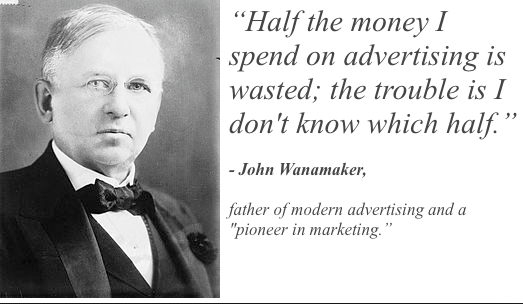
New research from CSO Insights suggests that the day may have come for sales. In their annual Sales Performance Optimization study of over 1500 companies across multiple industries, CSO found that the accuracy of sales forecasting fell to a near all-time low of 46.5%. Or as John Wanamaker might say; “Half of your sales efforts are wasted, you just don’t know which half. “
And since the forecast, defined in the study as near-term (30, 60 and 90 day), is an output of the sales pipeline, one could also conclude that half (or more) of the pipeline is “junk.”
With the wide spread adoption and utilization of CRM (84% of the firms surveyed), marketing automation, and analytical forecasting tools, the question is how can this be?
Here are some thoughts on why this might be happening, and five tips to help you improve your forecast.
Reasons for poor forecasting:
- Impurities in the System – let’s go after the big one first. “Garbage in, garbage out”…as they say. There’s a laundry list of things to look for — from reps putting leads in the system right before they close, to not updating opportunity consistently, and leaving in dead leads too long.
- Sales Optimism – yes, the economy seems to be recovering but it may not be moving at the “speed of sales.” Sales folks are an optimistic bunch; they want to believe things are better than they may be in reality. For example, the average length of the sales cycle. In a report earlier this year by BtoB Magazine, 43% of marketers reported that the sales cycle had increased over the last 3 years. Which is consistent with the CSO Insights report where 42% of Chief Sales Officers stated that the sales cycle had lengthened, in particular with new acquisitions.
- Incentives & Goals – take a look at how reps are being incented, and/or their sales goals. You may find the reason why reps leave opportunities in the pipeline too long, and/or are over optimistic with their forecast. Pressure to build and maintain pipeline can sometimes cause counter productive behaviors.
- Gut Feel – even if the troops in the trenches are putting in accurate and timely data, the generals may change it to fit the political environment and/or their own personal bias.
- Changing Buyer Behavior – recent research has shown that the buyer’s journey, and the typical sales process are not aligned. Buyers frequently start and stop the journey, or will cycle at a stage, and even move backward in the process. CRM systems are typically designed in a linear approach, progressing from a lead to a close. It’s an internal view, and increasingly out of alignment with buyers’ preferences.
How to improve:
- Active Pipeline Management – The pipeline and forecast will never be 100% accurate. That said, you should have a feel for how far off it is, and what is needed to improve. For example, do you have an inspection process to keep the pipeline current? If so, consider doing it more frequently. Move quarterly reviews to monthly. Also, if everyone is responsible for updating the pipeline, then no one is responsible. Consolidate the “maintenance and hygiene” of the pipeline to one person. Others may be responsible for providing updates, but one person needs to police the system.
- Discount Probability and Value – conduct a post-mortem on past forecasts over last year or two. Assess the difference between forecasted and actual results. Create discounted probabilities based on that delta for: lead movement (from stage to stage), and lead value. If implemented, evaluate the accuracy of your “pre-set” discounts. It should help bring forecasts more in-line and ground “sales optimism” in a bit of reality.
- Govern the Process – to improve the accuracy of “output”, focus on implementing and managing a standard process. Accenture’s Connecting the Dots on Sales Performance found inconsistencies among reps in using their company’s defined process and methodologies to selling. A quarter of Chief Sales Officers surveyed stated that sales reps used their sales methodologies 50% of the time, 31% said it was used 75% of the time.
- Leverage Marketing – close the feedback loop with marketing to improve the quality of leads from campaigns and activities. In a report on Sales & Marketing Alignment by the Aberdeen Group, marketing accounted for 47% of the sales forecasted pipeline in the Top 20% of companies studied, compared to only 5% of laggard organizations (bottom 20%).
- Utilize Business Intelligence Tools – high penetration rates of CRM may equate to high visibility, but doesn’t automatically mean that it provides the best insight. Despite high adoption rates of performance dashboard, few companies are using business intelligence or analytics tools according to the Aberdeen Group report on sales forecasting. However, the report found that 44% of the highest performing sales organizations were using predictive analytics to reduce “gut feel” in the forecast.

Of all the options, perhaps the best lever for impacting accuracy is the rep. As Ashish Vazirani, a Principal in the Hi-Tech practice of the sales consultancy, ZS Associates says; “A sales person needs to be coached, or apprenticed on how to discern and input the right information for accurate forecasting. Technology can make us lazy and reliant on the tools to do the thinking, we need to emphasize the importance coaching plays in keeping the garbage out of the system. ”
Helping the troops become better soldiers through coaching should help improve the accuracy of the forecast. As well as, implementing the tips mentioned above. But you may still find that half of the pipeline is wasted, but hopefully, unlike Mr. Wanamaker, you’ll understand which half.
by scott.gillum | Apr 18, 2013 | 2013
I grew up in a factory town, a community of craftsman. At 15, my grandfather watched as they built the factory where he would work for fifty years. On the day it opened he got a job working on the assembly line. At its peak, it employed 10,000 people.
During that time, the town grew and merchants prospered. But as production at the factories slowed and the work moved overseas, the merchants began to feel the impact, and when the big box retailers rolled in, it killed them. By my teens, the new reality was high unemployment, vacant storefronts, and the once thriving downtown shopping area was now a ghost town.
Started in Brooklyn in 2005, Etsy was the idea of Robert Kalin, Chris Maguire, and Haim Schoppik, who modeled it after open craft fairs. In an article in Wired magazine writer Rob Walker described Kalin’s vision as “a cultural movement that could revive the power and voice of the individual against the depersonalized landscape of big box retail.”
The site was originally designed to be an e-commerce platform for handmade items, on the belief that hand crafted items had “an intrinsic value” that should be given a forum outside of traditional retail. Etsy has since modified its policies to include designers of goods, and curators of vintage goods (20 years or older).
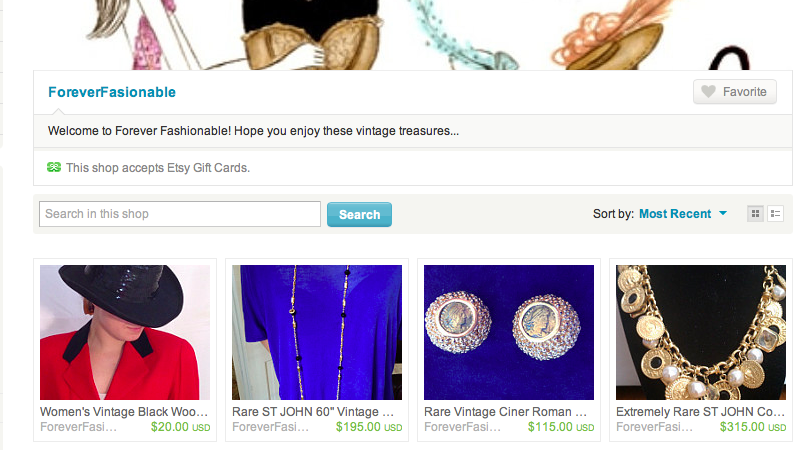
Example Vintage Shop – Forever Fashionable
It provides users (shop owners) a virtual storefront on the internet for a small fee of $0.20 per listed item. Providing global scale for small shop owners who design, build, or curate items such as art, jewelry and other handcrafted items.
Unlike the Fancy or Ebay, Etsy puts the focus on their shop owners, which now number 800,000. Visitors can read shop owner’s profiles, follow them, and see the items and shops they favor. Perhaps most interesting is the video series Etsy has created to tell the stories of it craftsman and curators, celebrating their passions, interest and ambitions.

Example Shop Owner Video
Etsy now enters an interesting time in its rapid rise. In order to scale to the next level, it must wrestle with the challenge that handmade items also come with production limitations. As the site tries to stay true to its founding vision of handcrafted items, it has loosened the rules to allowing for the option of “remote employees.”
It now acknowledges that not every designer actually has the desire and/or capability to build what he or she designs, permitting production to be outsourced to someone else.
Perhaps the most shocking change is that Etsy is piloting integrating into mainstream retail through an arrangement with West Elm (owned by Williams Sonoma) that would bring Etsy merchant’s products to the shelves of the nationwide chain.
For now, Etsy won’t put big box retailers out of business any time soon, but given the current state of retail it may be an evolution that is much needed. With the evolution of ecommerce and the rise of big box retailers also came the coldness of impersonal transactions.
Etsy offers its 25 million members the opportunity to develop a relationship with shop owners, to become an admirer of their work and/or appreciate their eye for style. A chance to do business on a personal level again, with someone they know, and/or share a similar interest or passion.
And as a result, it changes the buying experience from one of procuring an item because of the functionality or utility, to one of investing in the uniqueness of the idea that originated it, and in the skill of the craftsman that produced it.
Etsy offers all the things you loved about doing business with a small proprietor or craftsman in your local community without the geographic limitations. It’s an opportunity to reconnect to humanity and to the small merchants that built the downtown you knew as a kid.
by scott.gillum | Apr 7, 2013 | 2013, Opinion
Why do we do it? No one is forcing us. As Christopher McDougall points out in his brilliant book, Born to Run, we no longer need to chase down our food. So why do we do something physically and mentally challenging, and occasionally painful, if we don’t have to. Why not just take it easy?

This was the conversation inside my head early this weekend before the Cherry Blossum 10 Mile run in the Nation’s Capital. In fact, it’s the same conversation I have before any race. Why would anyone in their right mind stress themselves out for a week and get out of bed at 5:30 am on a weekend to run.
I spent the first 2-3 miles of the race observing people trying to answer that question. From what I saw, some folks run to challenge themselves, some run for others, like the a guy in a yellow kilt running for fallen combat soldiers, the woman with a picture of her deceased cat on her shirt, and of course, the group of sickos who do it because they actually enjoy it.
Me? Well, I’m another story. It’s taken me many years, several races, and 10 miles this weekend to figure it out. The truth is, I hate to run. It’s a means to an end. I like to race, but I hate to run. It’s a legacy of growing up playing sports, where running was a “have to” and not a “want to.”
Up until my 40th birthday, I had successfully avoided running, while slowly turning myself into a “fat and happy” sedimentary “couch” potato. That was until a colleague of mine issued the challenge of doing a sprint triathlon as a way for us to celebrate our 40th birthday (thank you Patrick).
Since that time, I train regularly and do various types of endurance races. Along the way, I dropped the 25 lb. bag of potatoes. I’ve gotten into a routine of training, but I hadn’t totally figured out why I continue to do races until this weekend. Alone with my thoughts for the next hour and half or so, I committed to figuring it out.
I know that I need to pick events that give purpose to my training routine. But the epiphany came at mile 5 when I realized that I think I actually like to scare myself to remind me not to become complicit and/or too comfortable again. My approach is to pick events I’ve never done, and to usually do them alone, because it heightens the fear factor.
The days and night before the race is spent stressing myself out about the course layout, logistics, and perhaps, most importantly, the locations of bathrooms. But along with the fear and the stress, I know there is also the heightened sense of accomplishment.
By mile 9, I realized that this habit had spilled over to my work life. I left a comfortable position three years ago to enter a new industry, and to start a new business with gyro. I “had it good,” but I decided shake things up, I had become in a sense “fat and happy” in my career.
Like training, we can easily fall into the “habit” of just going to work everyday. In fact, some probably dislike it as much as I dislike running. And I wonder if that might be because our work life sometimes lacks that “event” to give it purpose. It’s easy to fall into a routine and become comfortable. Life itself can be complicated, so why make it more difficult?
Perhaps a big, fat scary goal is what is needed give greater meaning to our work, and to reenergize us. With that fear of the unknown, and/or the unaccomplished, also comes the reminder of what it is to be alive.
Yes, it can be painful and uncomfortable, like how my lower back and calves feel as I write this, but you may also be pleasantly surprised. A sense of accomplishment can fuel the need to set bigger, more challenging ways to push yourself, becoming a habit. So, if you get a chance to be alone with your thoughts, ask yourself “why do you run?”
















